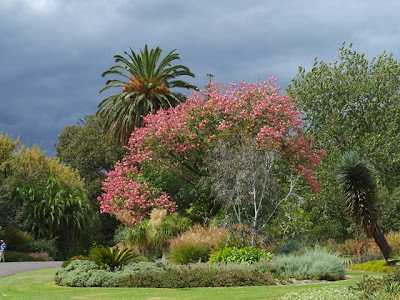Tardy publication solves a floss silk puzzle
You've got to admire the authors of a scientific paper who begin with a statement that the paper you are about to read "represents...the tardy completion of...studies...we initiated in the 1980s". The paper, a taxonomic revision of the genus Ceiba, was published in 2003.
And it gets better. A few pages in we get the line "Fortunately, over the intervening years, with one notable exception, few other people have taken an interest in the taxonomy of species of Ceiba or Chorisia, despite the great beauty of the flowers of these trees, and some confusion concerning their identity". Lucky them, and luck us. We get a taxonomic paper with wit as well as wisdom!
Oh, and you'll be thinking, here he goes again. That Entwisle guy has got obsessed with some minor taxonomic conundrum in some obscure plant group, as he does every now and then. Well, that's true I guess. But this completes a story I started some time ago in my first post on Ceiba and I don't like to leave things unfinished. (Oh, and I also like excuses to publish photos of a showy plant like this one...)
But back to the paper by Peter Gibbs and Joao Semir from the UK and Brazil repectively (although Gibbs was working for a while in a Brazlian university). The key to species quickly takes you to what they call the "Ceiba insignis aggregate species" - a collection of seven entities that are often difficult to discriminate.
If the flowers are lighter coloured we are in the vicinity of Ceiba insignis. If they are deep pink or red, at least distally, then its Ceiba speciosa or thereabouts.
Now I reckon the flowers I photographed on this Ceiba in Royal Botanic Gardens Melbourne's Water Conservation Garden are full on pink, at least for all but the very basal part. This means speciosa rather than insignis, and the same species I featured in my post from Sydney* rather what our Melbourne sign says.
I gather from this UBC Botanical Garden page that sometimes the flowers of the former can be slightly paler and those of the latter slightly pink. Still, I'll stick with my diagnosis and we may have to change this label.
That's no big deal and a healthy part of botanic garden management. Names change, mistakes are made, science advances. There are plenty of reasons for changing the name on a label. But no matter what that label says it will continue to attract attention with its spectacular show of pink flowers in early autumn, and it remains closely related to the kapok whose fruit fluff stuffs our pillows (oh, for that you'll have to read my first post on Ceiba).
*Postscript: Simon Goodwin from Royal Botanic Gardens Sydney has confirmed that they have one specimen of Ceiba insignis and it definitely has pale yellow flowers. Sydney also have a few Ceiba speciosa, like the one that I photographed and posted on two and a bit years ago but only in fruit.




Comments
jordan retro
nike air vapormax
air max 97
yeezys
jordan shoes
air max
birkin bag
jordans
goyard handbags